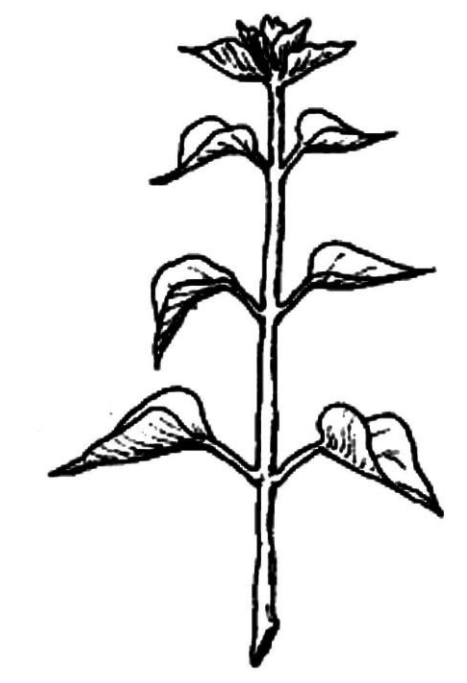
Opposite decussate phyllotaxy is seen in _______.
A. Guava
B. Calotropis
C. Jamun
D. Neirum
Answer
577.2k+ views
Hint: In opposite decussate phyllotaxy the leaves are opposite to each other. They are placed at right angles to one another.
Complete Answer:
The opposite phyllotaxy is seen in calotropis. Phyllotaxy is the arrangement of leaves on the stem and opposite means they are present on opposite sides i.e. leaves are placed at right angles to each other. The diagram of opposite decussate phyllotaxy is given below.
The correct answer is B. Calotropis.

Additional Information:
1) Phyllotaxy refers to the pattern or arrangement of leaves on the stem or branch of a plant. It is mainly of three types, alternate, opposite and whorled phyllotaxy.
2) In alternate phyllotaxy, a single leaf arises from the node of a branch. This type of phyllotaxy is observed in sunflower, mustard and people.
3) Plants with opposite phyllotaxy have two leaves arising from the node in opposite directions. It is found in guava and jamun plants.
4) Plants with whorled phyllotaxy have three or more leaves arising from the node. It is found in Alstonia. A whorl can occur as a basil structure where all the leaves are attached at the base of the shoot and the internodes are small or non existent.
5) In an opposite pattern , if successive leaf pairs are 90 degrees apart, this habit is called Decussate. It is common in members of the family Crassulaceae. Decussate phyllotaxy also occurs in Aizoaceae such as Lithops and conophytum.
Note: Plants like calotropis show opposite phyllotaxy. It is an arrangement of leaves on the stem. People use the bark and root bark for medicine. It is also used for digestive disorders like diarrhea, constipation and stomach ulcers. It is also useful in thick cramps, swelling, joint pain etc. thus, showing great medicinal properties.
Complete Answer:
The opposite phyllotaxy is seen in calotropis. Phyllotaxy is the arrangement of leaves on the stem and opposite means they are present on opposite sides i.e. leaves are placed at right angles to each other. The diagram of opposite decussate phyllotaxy is given below.
The correct answer is B. Calotropis.

Additional Information:
1) Phyllotaxy refers to the pattern or arrangement of leaves on the stem or branch of a plant. It is mainly of three types, alternate, opposite and whorled phyllotaxy.
2) In alternate phyllotaxy, a single leaf arises from the node of a branch. This type of phyllotaxy is observed in sunflower, mustard and people.
3) Plants with opposite phyllotaxy have two leaves arising from the node in opposite directions. It is found in guava and jamun plants.
4) Plants with whorled phyllotaxy have three or more leaves arising from the node. It is found in Alstonia. A whorl can occur as a basil structure where all the leaves are attached at the base of the shoot and the internodes are small or non existent.
5) In an opposite pattern , if successive leaf pairs are 90 degrees apart, this habit is called Decussate. It is common in members of the family Crassulaceae. Decussate phyllotaxy also occurs in Aizoaceae such as Lithops and conophytum.
Note: Plants like calotropis show opposite phyllotaxy. It is an arrangement of leaves on the stem. People use the bark and root bark for medicine. It is also used for digestive disorders like diarrhea, constipation and stomach ulcers. It is also useful in thick cramps, swelling, joint pain etc. thus, showing great medicinal properties.
Recently Updated Pages
Master Class 12 Business Studies: Engaging Questions & Answers for Success

Master Class 12 Economics: Engaging Questions & Answers for Success

Master Class 12 English: Engaging Questions & Answers for Success

Master Class 12 Maths: Engaging Questions & Answers for Success

Master Class 12 Social Science: Engaging Questions & Answers for Success

Master Class 12 Chemistry: Engaging Questions & Answers for Success

Trending doubts
Who was the first woman to receive Bharat Ratna?

Write a letter to the principal requesting him to grant class 10 english CBSE

Why is there a time difference of about 5 hours between class 10 social science CBSE

What is the median of the first 10 natural numbers class 10 maths CBSE

The Equation xxx + 2 is Satisfied when x is Equal to Class 10 Maths

Discuss the main reasons for poverty in India




